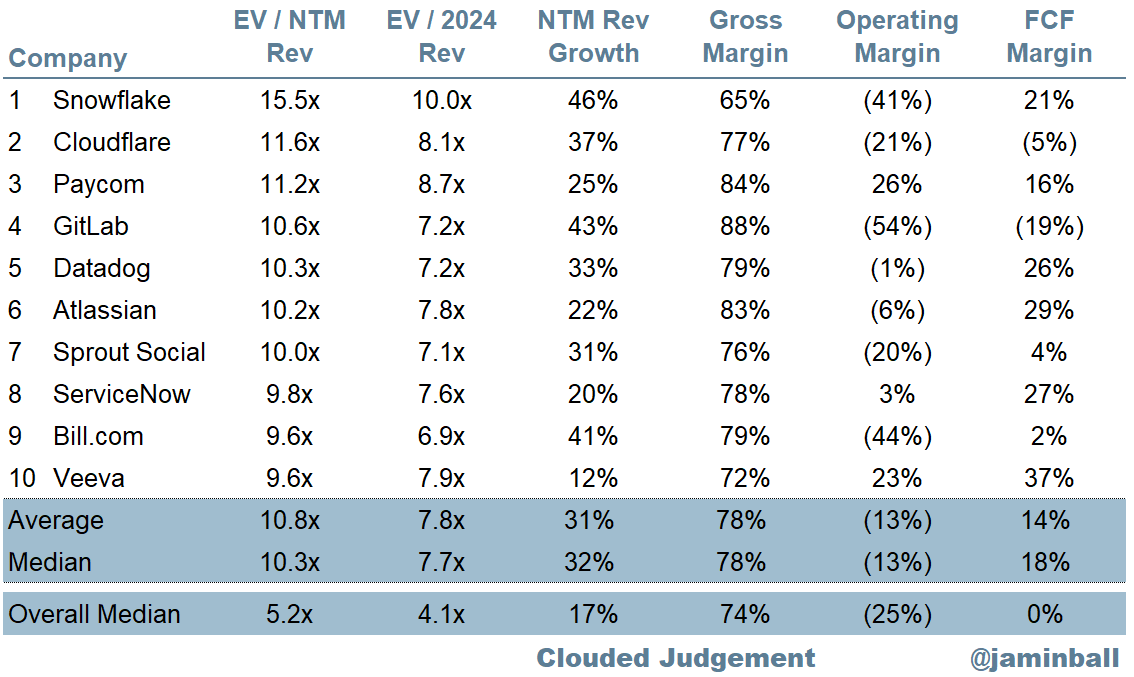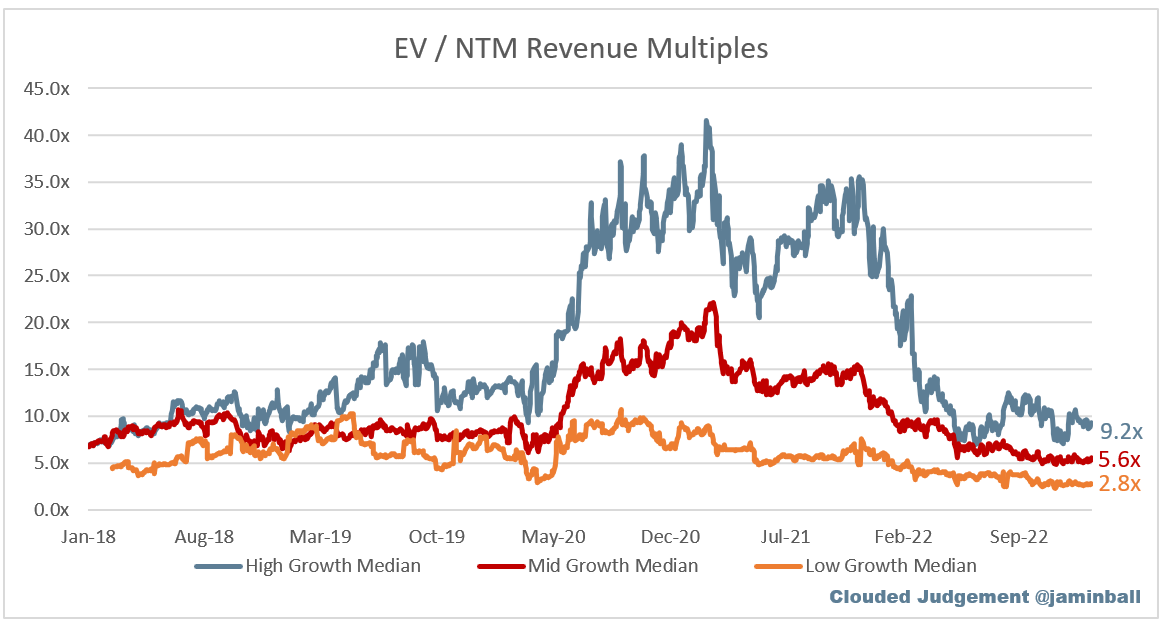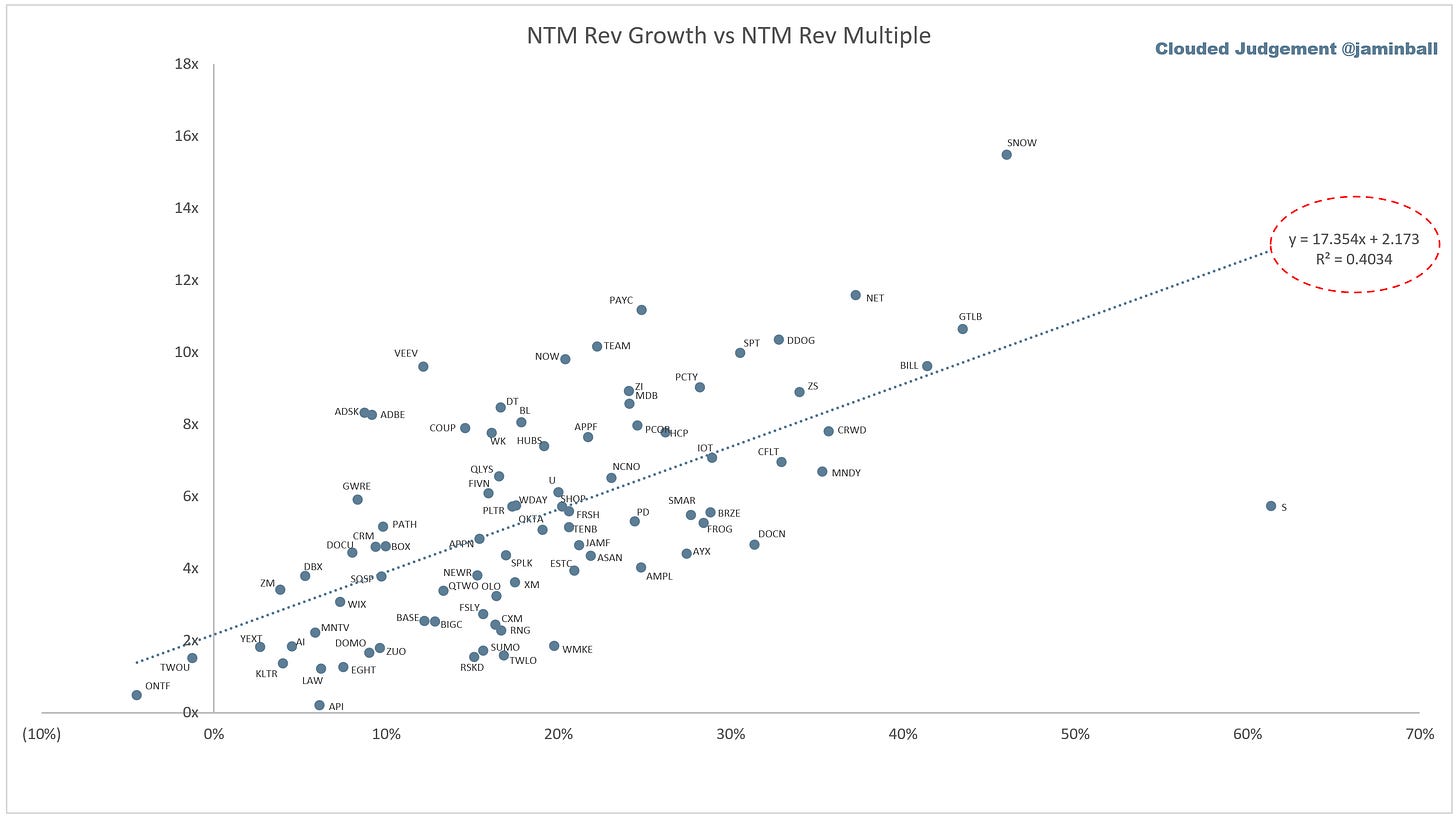Clouded Judgement 1.13.23 - CPI Update and Early Look at '23 Budgets
Every week I’ll provide updates on the latest trends in cloud software companies. Follow along to stay up to date!
CPI Update
December CPI figures came out yesterday. Here were the results:
Headline inflation was +6.5% YoY (-0.1% MoM) vs consensus of +6.5% YoY
Core inflation was +5.7% YoY (+0.3% MoM) vs consensus of +5.7% YoY
Both headline and core were right on consensus. The market had a pretty muted reaction to the CPI release for the first time in a while. You could argue that the muted reaction was a result of inflation being exactly what the expectations were, but I think this is only part of it. Inflation is now becoming more of a “known” thing. The market knows it’s coming down, this is no surprise. As I’ve talked about in the past, the main concern of the market currently is not inflation / rates, but fundamentals and what happens to business performance in a recession.
One interesting callout - the 10Y is currently 3.4%, down from ~4% to start the year just two weeks ago. Despite all of the higher for longer talk, the 10Y has stayed on the lower end. As a reminder - from 2010 - 2020 the average 10Y rate was ~2.3%. That was more broadly a period of ZIRP, and it’s interesting that today the 10Y isn’t hugely different from where it was in the period of 2010 - 2020
Morgan Stanley CIO Survey
Everyone is eagerly awaiting 2023 forecasts to be “de-risked.” How bad (or not bad in a soft landing) performance could be in 2023 is an unknown. When I hear people talking about numbers being “de-risked” (either inflation or forecasts) the way I think about it is when does the spectrum of possibilities converge, from a wide range to a much narrower range. Right now, the range is quite large. Companies will start providing full year 2023 guidance when we get to Q4 ‘22 earnings reports (starting in a few weeks) and we’ll get a peak into 2023 forecasts. Individual company performance is more of the bottoms up analysis on forecasts.
The top down analysis is looking at IT budget growth. The quarterly Morgan Stanley CIO survey suggests that CIOs believe IT budgets will grow 2.7% in 2023. The expectations 1 quarter ago was for 2.8% growth in 2023 (so not much change in 1 quarter). The average yearly growth in IT budgets from 2010 - 2019 was 4.1%, so the projections for 2023 are below the historical yearly average. However, a projection of +2.7% still seems quite healthy, all things considered.
The below chart shows the evolution of forward year budget projections going back to ‘07. The purple line on the far right represents the ‘23 forecasts.
The graph below shows the same graph, but instead of all IT budgets, just looking at Software spending budgets
Top 10 EV / NTM Revenue Multiples
Top 10 Weekly Share Price Movement
Update on Multiples
SaaS businesses are generally valued on a multiple of their revenue - in most cases the projected revenue for the next 12 months. Revenue multiples are a shorthand valuation framework. Given most software companies are not profitable, or not generating meaningful FCF, it’s the only metric to compare the entire industry against. Even a DCF is riddled with long term assumptions. The promise of SaaS is that growth in the early years leads to profits in the mature years. Multiples shown below are calculated by taking the Enterprise Value (market cap + debt - cash) / NTM revenue.
Overall Stats:
Overall Median: 5.2x
Top 5 Median: 11.2x
10Y: 3.4%
Bucketed by Growth. In the buckets below I consider high growth >30% projected NTM growth, mid growth 15%-30% and low growth <15%
High Growth Median: 9.2x
Mid Growth Median: 5.6x
Low Growth Median: 2.8x
Scatter Plot of EV / NTM Rev Multiple vs NTM Rev Growth
How correlated is growth to valuation multiple?
Growth Adjusted EV / NTM Rev
The below chart shows the EV / NTM revenue multiple divided by NTM consensus growth expectations. The goal of this graph is to show how relatively cheap / expensive each stock is relative to their growth expectations
Operating Metrics
Median NTM growth rate: 17%
Median LTM growth rate: 29%
Median Gross Margin: 74%
Median Operating Margin (25%)
Median FCF Margin: 0%
Median Net Retention: 119%
Median CAC Payback: 38 months
Median S&M % Revenue: 48%
Median R&D % Revenue: 28%
Median G&A % Revenue: 20%
Comps Output
Rule of 40 shows LTM growth rate + LTM FCF Margin. FCF calculated as Cash Flow from Operations - Capital Expenditures
GM Adjusted Payback is calculated as: (Previous Q S&M) / (Net New ARR in Q x Gross Margin) x 12 . It shows the number of months it takes for a SaaS business to payback their fully burdened CAC on a gross profit basis. Most public companies don’t report net new ARR, so I’m taking an implied ARR metric (quarterly subscription revenue x 4). Net new ARR is simply the ARR of the current quarter, minus the ARR of the previous quarter. Companies that do not disclose subscription rev have been left out of the analysis and are listed as NA.
This post and the information presented are intended for informational purposes only. The views expressed herein are the author’s alone and do not constitute an offer to sell, or a recommendation to purchase, or a solicitation of an offer to buy, any security, nor a recommendation for any investment product or service. While certain information contained herein has been obtained from sources believed to be reliable, neither the author nor any of his employers or their affiliates have independently verified this information, and its accuracy and completeness cannot be guaranteed. Accordingly, no representation or warranty, express or implied, is made as to, and no reliance should be placed on, the fairness, accuracy, timeliness or completeness of this information. The author and all employers and their affiliated persons assume no liability for this information and no obligation to update the information or analysis contained herein in the future.














Really good analysis